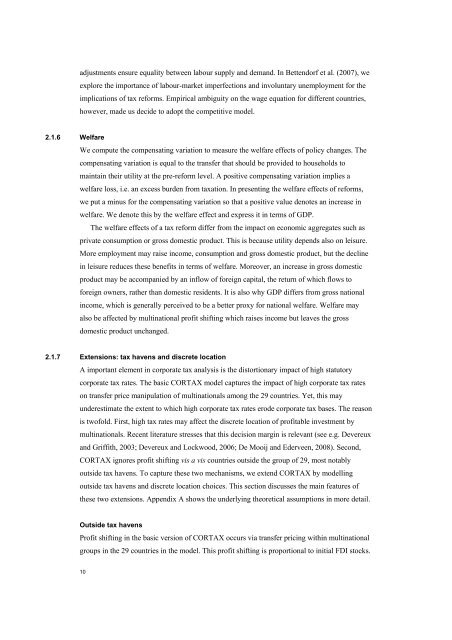The economic effects of EU-reforms in corporate income tax systems
The economic effects of EU-reforms in corporate income tax systems
The economic effects of EU-reforms in corporate income tax systems
Create successful ePaper yourself
Turn your PDF publications into a flip-book with our unique Google optimized e-Paper software.
adjustments ensure equality between labour supply and demand. In Bettendorf et al. (2007), we<br />
explore the importance <strong>of</strong> labour-market imperfections and <strong>in</strong>voluntary unemployment for the<br />
implications <strong>of</strong> <strong>tax</strong> <strong>reforms</strong>. Empirical ambiguity on the wage equation for different countries,<br />
however, made us decide to adopt the competitive model.<br />
2.1.6 Welfare<br />
We compute the compensat<strong>in</strong>g variation to measure the welfare <strong>effects</strong> <strong>of</strong> policy changes. <strong>The</strong><br />
compensat<strong>in</strong>g variation is equal to the transfer that should be provided to households to<br />
ma<strong>in</strong>ta<strong>in</strong> their utility at the pre-reform level. A positive compensat<strong>in</strong>g variation implies a<br />
welfare loss, i.e. an excess burden from <strong>tax</strong>ation. In present<strong>in</strong>g the welfare <strong>effects</strong> <strong>of</strong> <strong>reforms</strong>,<br />
we put a m<strong>in</strong>us for the compensat<strong>in</strong>g variation so that a positive value denotes an <strong>in</strong>crease <strong>in</strong><br />
welfare. We denote this by the welfare effect and express it <strong>in</strong> terms <strong>of</strong> GDP.<br />
<strong>The</strong> welfare <strong>effects</strong> <strong>of</strong> a <strong>tax</strong> reform differ from the impact on <strong>economic</strong> aggregates such as<br />
private consumption or gross domestic product. This is because utility depends also on leisure.<br />
More employment may raise <strong>in</strong>come, consumption and gross domestic product, but the decl<strong>in</strong>e<br />
<strong>in</strong> leisure reduces these benefits <strong>in</strong> terms <strong>of</strong> welfare. Moreover, an <strong>in</strong>crease <strong>in</strong> gross domestic<br />
product may be accompanied by an <strong>in</strong>flow <strong>of</strong> foreign capital, the return <strong>of</strong> which flows to<br />
foreign owners, rather than domestic residents. It is also why GDP differs from gross national<br />
<strong>in</strong>come, which is generally perceived to be a better proxy for national welfare. Welfare may<br />
also be affected by mult<strong>in</strong>ational pr<strong>of</strong>it shift<strong>in</strong>g which raises <strong>in</strong>come but leaves the gross<br />
domestic product unchanged.<br />
2.1.7 Extensions: <strong>tax</strong> havens and discrete location<br />
A important element <strong>in</strong> <strong>corporate</strong> <strong>tax</strong> analysis is the distortionary impact <strong>of</strong> high statutory<br />
<strong>corporate</strong> <strong>tax</strong> rates. <strong>The</strong> basic CORTAX model captures the impact <strong>of</strong> high <strong>corporate</strong> <strong>tax</strong> rates<br />
on transfer price manipulation <strong>of</strong> mult<strong>in</strong>ationals among the 29 countries. Yet, this may<br />
underestimate the extent to which high <strong>corporate</strong> <strong>tax</strong> rates erode <strong>corporate</strong> <strong>tax</strong> bases. <strong>The</strong> reason<br />
is tw<strong>of</strong>old. First, high <strong>tax</strong> rates may affect the discrete location <strong>of</strong> pr<strong>of</strong>itable <strong>in</strong>vestment by<br />
mult<strong>in</strong>ationals. Recent literature stresses that this decision marg<strong>in</strong> is relevant (see e.g. Devereux<br />
and Griffith, 2003; Devereux and Lockwood, 2006; De Mooij and Ederveen, 2008). Second,<br />
CORTAX ignores pr<strong>of</strong>it shift<strong>in</strong>g vis a vis countries outside the group <strong>of</strong> 29, most notably<br />
outside <strong>tax</strong> havens. To capture these two mechanisms, we extend CORTAX by modell<strong>in</strong>g<br />
outside <strong>tax</strong> havens and discrete location choices. This section discusses the ma<strong>in</strong> features <strong>of</strong><br />
these two extensions. Appendix A shows the underly<strong>in</strong>g theoretical assumptions <strong>in</strong> more detail.<br />
Outside <strong>tax</strong> havens<br />
Pr<strong>of</strong>it shift<strong>in</strong>g <strong>in</strong> the basic version <strong>of</strong> CORTAX occurs via transfer pric<strong>in</strong>g with<strong>in</strong> mult<strong>in</strong>ational<br />
groups <strong>in</strong> the 29 countries <strong>in</strong> the model. This pr<strong>of</strong>it shift<strong>in</strong>g is proportional to <strong>in</strong>itial FDI stocks.<br />
10
















